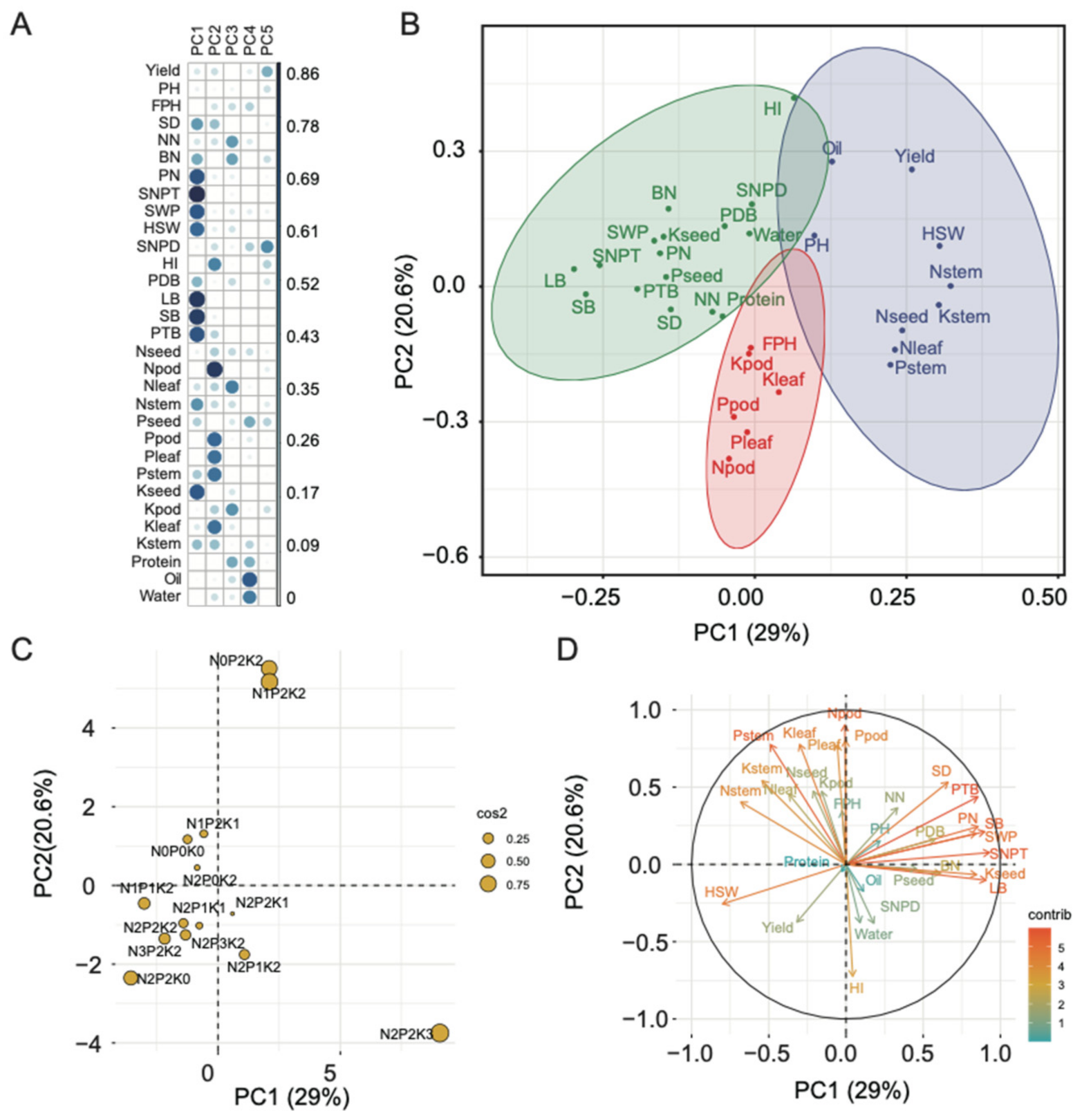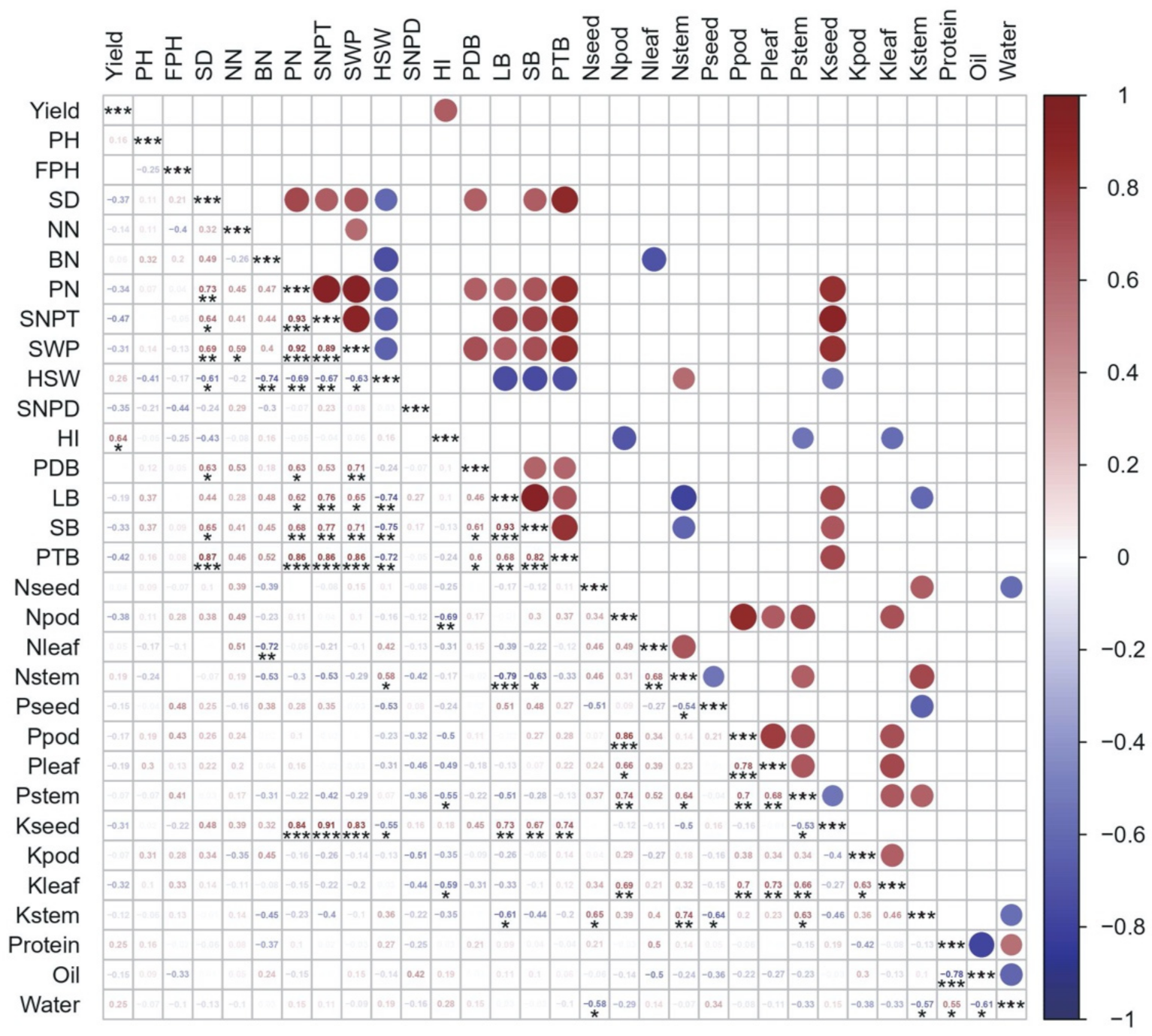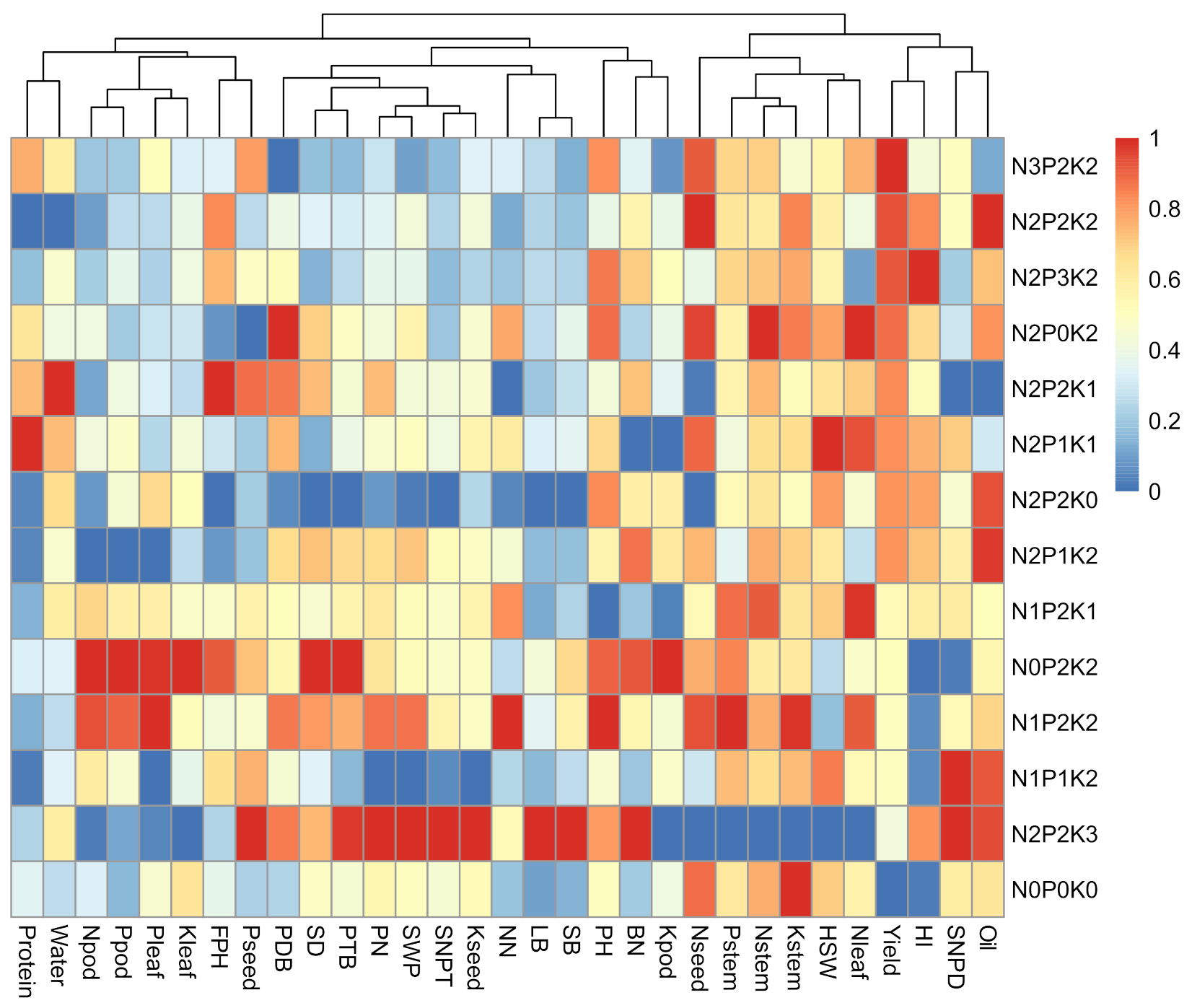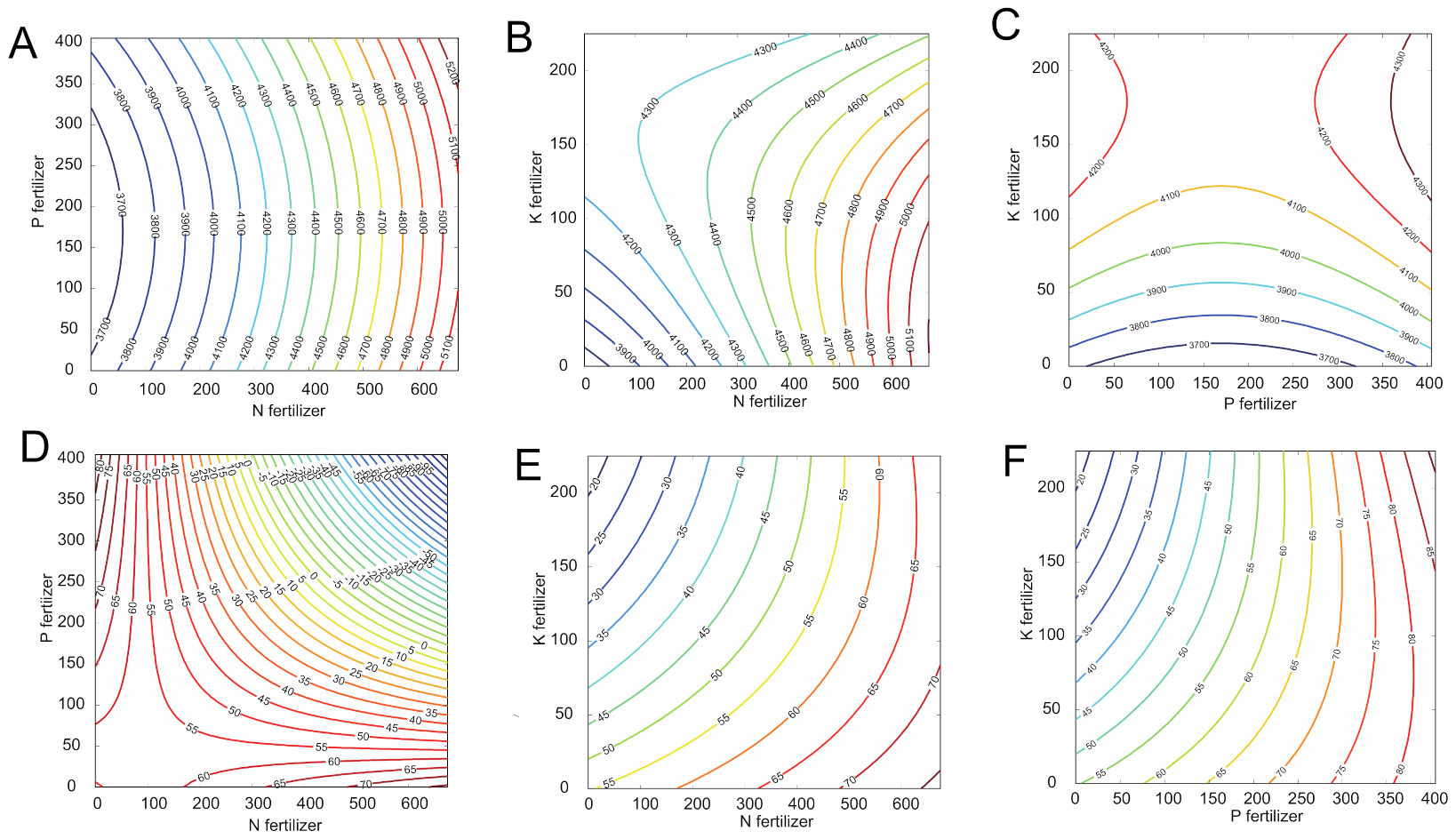Optimal Fertilization Level for Yield, Biological and Quality Traits of Soybean under Drip Irrigation System in the Arid Region of Northwest China
Abstract
:1. Introduction
2. Materials and Methods
2.1. Experimental Site
2.2. Experimental Materials and Design
2.3. Field Management and Cultivation Conditions
2.4. Data Observations
2.5. Data Analysis
3. Results
3.1. Principal Component and Correlation Analyses
3.2. Effects of Different Fertilization Interactions on Grain Yield
3.3. Optimal Fertilization Model Development
3.4. Optimal Fertilizer Application
4. Discussion
5. Conclusions
Supplementary Materials
Author Contributions
Funding
Institutional Review Board Statement
Informed Consent Statement
Data Availability Statement
Acknowledgments
Conflicts of Interest
References
- Wang, H.; Ni, C.; Xu, R. Analysis of change and convergence of soybean productivity in China. Jiangsu J. Agric. Sci. 2011, 27, 199–203. [Google Scholar]
- Zhang, F.; Niu, J.; Zhang, W.; Chen, X.; Li, C.; Yuan, L.; Xie, J. Potassium nutrition of crops under varied regimes of nitrogen supply. Plant Soil 2010, 335, 21–34. [Google Scholar] [CrossRef]
- Fu, C.F.; Sun, C.; Dong, Y.M. Effects of nutrient management on NPK uptake and yield of soybean. Heilongjiang Agr. Sci. 2011, 10, 33–35. [Google Scholar]
- Ciampitti, I.A.; Salvagiotti, F. New insights into soybean biological nitrogen fixation. Agron. J. 2018, 10, 1185–1196. [Google Scholar] [CrossRef] [Green Version]
- Salvagiotti, F.; Cassman, K.G.; Specht, J.E.; Walters, D.T.; Weiss, A.; Dobermann, A. Nitrogen uptake, fixation and response to fertilizer N in soybeans: A review. Field Crop. Res. 2008, 108, 1–13. [Google Scholar] [CrossRef] [Green Version]
- Yang, F.; Xu, X.; Wang, W.; Ma, J.; Wei, D.; He, P.; Pampolino, M.F.; Johnston, A.M. Estimating nutrient uptake requirements for soybean using QUEFTS model in China. PLoS ONE 2017, 12, e0177509. [Google Scholar] [CrossRef]
- Zapata, F.; Danso, S.K.A.; Hardarson, G.; Fried, M. Time Course of Nitrogen Fixation in Field-Grown Soybean Using Nitrogen-15 Methodology1. Agron. J. 1987, 79, 172–176. [Google Scholar] [CrossRef]
- Li, L.; Yang, T.; Redden, R.; He, W.F.; Zong, X.X. Soil fertility map for food legumes production areas in China. Sci. Rep. 2016, 6, 26102. [Google Scholar] [CrossRef] [Green Version]
- Fan, J.; Lu, X.; Gu, S.; Guo, X. Improving nutrient and water use efficiencies using water-drip irrigation and fertilization technology in Northeast China. Agric. Water Manag. 2020, 241, 106352. [Google Scholar] [CrossRef]
- Tang, P.; Li, H.; Issaka, Z.; Chen, C. Effect of manifold layout and fertilizer solution concentration on fertilization and flushing times and uniformity of drip irrigation systems. Agric. Water Manag. 2018, 200, 71–79. [Google Scholar] [CrossRef]
- Zou, H.; Fan, J.; Zhang, F.; Xiang, Y.; Wu, L.; Yan, S. Optimization of drip irrigation and fertilization regimes for high grain yield, crop water productivity and economic benefits of spring maize in Northwest China. Agric. Water Manag. 2020, 230, 105986. [Google Scholar] [CrossRef]
- Chen, Y.; Zhou, X.; Lin, Y.; Ma, L. Pumpkin yield affected by soil nutrients and the interactions of Nitrogen, Phosphorus, and Potassium fertilizers. HortScience 2019, 54, 1831–1835. [Google Scholar] [CrossRef] [Green Version]
- Yang, Z.J.; Wu, X.H.; Grossnickle, S.C.; Chen, L.H.; Yu, X.X.; El-Kassaby, Y.A.; Feng, J.L. Formula fertilization promotes Phoebe bournei robust seedling cultivation. Forests 2020, 11, 781. [Google Scholar] [CrossRef]
- Yin, Z.C.; Guo, W.Y.; Liang, J.; Xiao, H.Y.; Hao, X.Y.; Hou, A.F.; Zong, X.X.; Leng, T.R.; Wang, Y.J.; Wang, Q.Y.; et al. Effects of multiple N, P, and K fertilizer combinations on adzuki bean (Vigna angularis) yield in a semi-arid region of northeastern China. Sci. Rep. 2019, 9, 19408. [Google Scholar] [CrossRef] [PubMed] [Green Version]
- Parry, M.A.; Reynolds, M.; Salvucci, M.E.; Raines, C.; Andralojc, P.J.; Zhu, X.G.; Price, G.D.; Condon, A.G.; Furbank, R.T. Raising yield potential of wheat. II. Increasing photosynthetic capacity and efficiency. J. Exp. Bot. 2010, 62, 453–467. [Google Scholar] [CrossRef]
- Fischer, R.; Rees, D.; Sayre, K.; Lu, Z.M.; Condon, A.; Saavedra, A.L. Wheat yield progress associated with higher stomatal conductance and photosynthetic rate, and cooler canopies. Crop Sci. 1998, 38, 1467–1475. [Google Scholar] [CrossRef]
- Jin, J.; Liu, X.; Wang, G.; Mi, L.; Shen, Z.; Chen, X.; Herbert, S.J. Agronomic and physiological contributions to the yield improvement of soybean cultivars released from 1950 to 2006 in Northeast China. Field Crops Res. 2010, 115, 116–123. [Google Scholar] [CrossRef]
- Board, J.E.; Modali, H. Dry matter accumulation predictors for optimal yield in soybean. Crop Sci. 2005, 45, 1790–1799. [Google Scholar] [CrossRef]
- Huang, Z.W.; Zhao, T.J.; Gai, J.Y. Dynamic analysis of biomass accumulation and partition in soybean with different yield levels. Crop Sci. 2009, 35, 1483–1490. [Google Scholar] [CrossRef]
- Mehetre, S.S.; Jamadagni, B.M. Biomass partitioning and growth characters in relation to plant architecture in soybean. Soybean Genet. Newsl. 1996, 23, 92–97. [Google Scholar]
- IUSS Working Group WRB. International soil classification system for naming soils and creating legends for soil maps. In World Reference Base for Soil Resources 2014; update 2015; Food and Agriculture Organization of the United Nations: Rome, Italy, 2015. [Google Scholar]
- Wang, L.; Wang, L.Z.; Zhao, R.J.; Li, Q. Development of new soybean cultivar Zhonghuang 35 with high yielding, high oil, early maturity and broad adaptability. Soybean Sci. 2009, 28, 360–362. [Google Scholar]
- Wang, L.Z.; Luo, G.T.; Wang, L.; Sun, J.M.; Zhang, Y. Development of soybean cultivation technology with the yield over 6 tonnes per hectare for soybean cultivar Zhonghuang 35 in northern Xinjiang province. Soybean Sci. 2012, 31, 217–223. [Google Scholar]
- Bao, S.D. Soil Agrochemical Analysis; China Agricultural Press: Beijing, China, 2000; pp. 25–114. [Google Scholar]
- Zhang, Y.; He, J.; Wang, H.; Meng, S.; Xing, G.; Li, Y.; Yang, S.; Zhao, J.; Zhao, T.; Gai, J. Detecting the QTL-allele system of seed oil traits using multi-locus genome-wide association analysis for population characterization and optimal cross prediction in soybean. Front. Plant Sci. 2018, 9, 1793. [Google Scholar] [CrossRef] [PubMed] [Green Version]
- Kolde, R. Pheatmap: Pretty Heatmaps; R Package Version; CRC Press: Boca Raton, FL, USA, 2012; Volume 61, p. 915. [Google Scholar]
- Wei, T.; Simko, V. Corrplot: Visualization of a Correlation Matrix; R Package Version; CRC Press: Boca Raton, FL, USA, 2013; p. 230. [Google Scholar]
- Maechler, M.; Rousseeuw, P.; Struyf, A.; Hubert, M.; Hornik, K. Package ‘cluster’. Dosegljivo na. 2013. Available online: https://cran.r-project.org/web/packages/cluster/cluster.pdf (accessed on 20 January 2022).
- Lumley, T.; Miller, A. Package ‘leaps’. In Regression Subset Selection, R package version; CRC Press: Boca Raton, FL, USA, 2009; Volume 2, p. 2366. [Google Scholar]
- Grant, M.; Boyd, S.; Ye, Y. CVX: Matlab Software for Disciplined Convex Programming; CVX: San Ramon, CA, USA, 2008. [Google Scholar]
- Seyfi, K.; Rashidi, M. Effect of drip irrigation and plastic mulch on crop yield and yield components of cantaloupe. Int. J. Agric. Biol. 2007, 9, 247–249. [Google Scholar]
- He, H.; Wang, Z.; Guo, L.; Zheng, X.; Zhang, J.; Li, W.; Fan, B. Distribution characteristics of residual film over a cotton field under long-term film mulching and drip irrigation in an oasis agroecosystem. Soil Till. Res. 2018, 180, 194–203. [Google Scholar] [CrossRef]
- Akhtar, K.; Wang, W.; Ren, G.; Khan, A.; Feng, Y.; Yang, G.; Wang, H. Integrated use of straw mulch with nitrogen fertilizer improves soil functionality and soybean production. Environ. Int. 2019, 132, 105092. [Google Scholar] [CrossRef] [PubMed]
- Li, F.M.; Wang, P.; Wang, J.; Xu, J.Z. Effects of irrigation before sowing and plastic film mulching on yield and water uptake of spring wheat in semiarid Loess Plateau of China. Agric. Water Manag. 2004, 67, 77–88. [Google Scholar] [CrossRef]
- Zhang, D.; Liu, H.B.; Hu, W.L.; Qin, X.H.; Yan, C.R.; Wang, H.Y. The status and distribution characteristics of residual mulching film in Xinjiang, China. J. Integr. Agric. 2016, 15, 2639–2646. [Google Scholar] [CrossRef] [Green Version]
- Galloway, J.N.; Winiwarter, W.; Leip, A.; Leach, A.M.; Bleeker, A.; Erisman, J.W. Nitrogen footprints: Past, present and future. Environ. Res. Lett. 2014, 9, 115003. [Google Scholar] [CrossRef]
- Chen, X.P.; Zhang, F.S. The technical index system of soil testing and fertilization was established through “3414” test. China Agric. Technol. Ext. 2006, 4, 36–39. [Google Scholar]
- Zhao, B.; Wang, Y.; Zhang, Z.Y.; Zhu, X.D.; Yang, R. Identification and optimization of extreme value of effect function of multivariate secondary fertilizer. Rain Fed Crops 2001, 21, 42–45. [Google Scholar]
- Wang, S.R.; Chen, X.P.; Gao, X.Z.; Mao, D.R.; Zhang, F.S. Study on simulation of “3414” fertilizer experiments. Plant Nutr. Fertil. Sci. 2002, 8, 409–413. [Google Scholar]
- Peng, S.B.; Cheng, Y.X.; Dong, W.H.; Liu, D.L. “3414” fertilization tests and regression analysis of recommended fertilizer amount of walnut. Nonwood For. Res. 2018, 36, 27–32. [Google Scholar]
- Ma, R.X.; Wang, J.S.; Li, X.Z.; Liu, W.C. Effect of different npk fertilizers cooperating application on yield and quality of high starch maize. In Applied Mechanics and Materials; Trans Tech Publications Ltd.: Bäch SZ, Switzerland, 2012; Volume 214, pp. 423–429. [Google Scholar]






| No. | Treatment | Urea (kg ha−1) | Monoammonium Phosphate (kg ha−1) | Potassium Chloride (kg ha−1) | Total Fertilizer in the Block (kg) | ||
|---|---|---|---|---|---|---|---|
| (N:46%) | (P2O5:61%) | (K2O:62%) | Urea | Monoammonium Phosphate | Potassium Chloride | ||
| 1 | N0P0K0 | 0 | 0 | 0 | 0.00 | 0.00 | 0.00 |
| 2 | N0P2K2 | 0 | 519 | 0 | 0.00 | 1.05 | 0.00 |
| 3 | N1P2K2 | 374 | 443 | 242 | 0.75 | 0.89 | 0.49 |
| 4 | N2P0K2 | 978 | 0 | 242 | 1.97 | 0.00 | 0.49 |
| 5 | N2P1K2 | 921 | 221 | 242 | 1.86 | 0.45 | 0.49 |
| 6 | N2P2K2 | 863 | 443 | 242 | 1.74 | 0.89 | 0.49 |
| 7 | N2P3K2 | 805 | 664 | 242 | 1.62 | 1.34 | 0.49 |
| 8 | N2P2K0 | 863 | 443 | 0 | 1.74 | 0.89 | 0.00 |
| 9 | N2P2K1 | 863 | 443 | 121 | 1.74 | 0.89 | 0.24 |
| 10 | N3P2K2 | 1352 | 443 | 242 | 2.73 | 0.89 | 0.49 |
| 11 | N1P1K2 | 431 | 221 | 242 | 0.87 | 0.45 | 0.49 |
| 12 | N1P2K1 | 374 | 443 | 121 | 0.75 | 0.89 | 0.24 |
| 13 | N2P1K1 | 921 | 221 | 121 | 1.86 | 0.45 | 0.24 |
| 14 | N2P2K3 | 863 | 443 | 363 | 1.74 | 0.89 | 0.73 |
| Rep | Treatment | Yield | PH | FPH | SD | NN | BN | PN | SNPT | SWP | HSW | SNPD | HI | PDB | LB | SB | PTB | Nseed | Npod | Nleaf | Nstem | Pseed | Ppod | Pleaf | Pstem | Kseed | Kpod | Kleaf | Kstem | Protein | Oil | Water |
|---|---|---|---|---|---|---|---|---|---|---|---|---|---|---|---|---|---|---|---|---|---|---|---|---|---|---|---|---|---|---|---|---|
| Unit | kg ha−1 | cm | g | g | g kg−1 | % | ||||||||||||||||||||||||||
| 1 | N0P0K0 | 3726.50 | 79.84 | 11.33 | 0.71 | 17.80 | 0.80 | 62.43 | 149.52 | 29.60 | 21.61 | 2.46 | 0.51 | 9.58 | 29.80 | 12.19 | 54.92 | 48.86 | 9.57 | 13.99 | 9.85 | 5.22 | 1.25 | 1.62 | 1.42 | 12.63 | 17.57 | 7.79 | 6.94 | 39.38 | 21.87 | 6.83 |
| 2 | N0P2K2 | 4195.88 | 82.68 | 12.23 | 0.77 | 17.90 | 1.28 | 64.17 | 150.97 | 29.85 | 20.30 | 2.36 | 0.50 | 10.92 | 39.45 | 17.20 | 65.22 | 48.58 | 11.38 | 13.69 | 8.83 | 5.52 | 1.85 | 1.88 | 1.63 | 12.49 | 19.52 | 9.00 | 6.01 | 39.37 | 21.77 | 6.87 |
| 3 | N1P2K2 | 4190.40 | 83.31 | 11.41 | 0.75 | 18.72 | 1.03 | 69.90 | 156.10 | 33.19 | 20.06 | 2.45 | 0.51 | 12.34 | 36.86 | 16.19 | 60.84 | 48.99 | 11.19 | 15.16 | 9.83 | 5.36 | 1.78 | 1.89 | 1.77 | 12.48 | 17.69 | 7.38 | 6.91 | 39.15 | 21.93 | 6.83 |
| 4 | N2P0K2 | 4543.75 | 82.52 | 10.83 | 0.74 | 18.46 | 0.82 | 59.67 | 133.78 | 30.17 | 21.85 | 2.41 | 0.55 | 12.95 | 34.21 | 14.39 | 55.68 | 49.02 | 9.80 | 15.46 | 11.30 | 5.08 | 1.29 | 1.54 | 1.38 | 12.39 | 17.50 | 6.64 | 6.59 | 39.70 | 22.10 | 6.90 |
| 5 | N2P1K2 | 4483.75 | 80.24 | 10.84 | 0.74 | 18.10 | 1.25 | 65.02 | 153.74 | 31.73 | 21.34 | 2.46 | 0.55 | 11.48 | 31.49 | 12.55 | 59.19 | 48.53 | 8.71 | 13.02 | 9.84 | 5.20 | 1.14 | 1.40 | 1.18 | 12.48 | 18.26 | 6.53 | 6.20 | 39.05 | 22.30 | 6.93 |
| 6 | N2P2K2 | 4590.75 | 79.10 | 12.10 | 0.70 | 17.73 | 1.03 | 57.68 | 135.95 | 28.97 | 21.23 | 2.45 | 0.56 | 10.27 | 33.38 | 12.62 | 52.55 | 49.13 | 8.97 | 13.46 | 8.85 | 5.24 | 1.33 | 1.52 | 1.43 | 12.28 | 17.52 | 6.93 | 6.56 | 39.00 | 22.33 | 6.70 |
| 7 | N2P3K2 | 4584.25 | 82.36 | 11.96 | 0.68 | 17.82 | 1.13 | 58.43 | 132.04 | 28.51 | 21.17 | 2.40 | 0.57 | 10.79 | 34.11 | 13.09 | 51.42 | 47.69 | 9.30 | 12.44 | 9.51 | 5.37 | 1.41 | 1.51 | 1.49 | 11.60 | 17.89 | 7.00 | 6.39 | 39.20 | 21.98 | 6.93 |
| 8 | N2P2K0 | 4484.00 | 82.18 | 10.69 | 0.66 | 17.65 | 1.05 | 51.89 | 121.45 | 25.26 | 21.86 | 2.44 | 0.55 | 8.79 | 26.59 | 10.86 | 46.80 | 46.78 | 8.93 | 13.61 | 8.94 | 5.21 | 1.45 | 1.73 | 1.35 | 11.64 | 18.11 | 7.33 | 5.70 | 39.05 | 22.25 | 7.03 |
| 9 | N2P2K1 | 4500.50 | 79.38 | 12.39 | 0.74 | 17.60 | 1.15 | 66.69 | 147.95 | 29.06 | 21.41 | 2.36 | 0.54 | 12.36 | 32.25 | 13.46 | 54.99 | 46.84 | 9.02 | 14.46 | 9.69 | 5.62 | 1.43 | 1.56 | 1.37 | 12.37 | 17.39 | 6.55 | 5.75 | 39.82 | 21.08 | 7.20 |
| 10 | N3P2K2 | 4654.50 | 82.09 | 11.26 | 0.68 | 17.96 | 0.89 | 56.49 | 131.55 | 26.01 | 21.15 | 2.45 | 0.53 | 8.54 | 34.04 | 12.13 | 49.81 | 48.93 | 9.23 | 14.62 | 9.40 | 5.56 | 1.29 | 1.65 | 1.49 | 11.97 | 16.48 | 6.74 | 5.62 | 39.85 | 21.23 | 7.00 |
| 11 | N1P1K2 | 4189.25 | 79.60 | 11.81 | 0.70 | 17.87 | 0.79 | 49.95 | 124.79 | 25.02 | 22.05 | 2.54 | 0.51 | 10.51 | 31.13 | 13.40 | 49.62 | 47.48 | 10.31 | 13.88 | 9.21 | 5.54 | 1.47 | 1.40 | 1.53 | 10.78 | 17.79 | 6.92 | 6.30 | 39.03 | 22.23 | 6.87 |
| 12 | N1P2K1 | 4219.00 | 76.49 | 11.49 | 0.71 | 18.52 | 0.79 | 63.92 | 151.40 | 29.87 | 21.62 | 2.47 | 0.54 | 10.78 | 30.27 | 13.02 | 57.08 | 48.04 | 10.53 | 15.41 | 10.78 | 5.42 | 1.55 | 1.68 | 1.67 | 12.73 | 16.34 | 7.23 | 6.02 | 39.17 | 21.72 | 7.00 |
| 13 | N2P1K1 | 4491.25 | 81.07 | 11.18 | 0.67 | 18.28 | 0.66 | 60.51 | 146.70 | 29.63 | 22.46 | 2.48 | 0.55 | 11.83 | 35.96 | 14.17 | 54.04 | 48.89 | 9.82 | 15.24 | 9.15 | 5.21 | 1.47 | 1.52 | 1.24 | 12.72 | 16.23 | 7.07 | 6.13 | 40.12 | 21.47 | 7.07 |
| 14 | N2P2K3 | 4112.50 | 82.00 | 11.08 | 0.74 | 18.20 | 1.33 | 72.65 | 183.90 | 34.35 | 19.57 | 2.53 | 0.55 | 12.33 | 55.84 | 20.28 | 64.77 | 46.79 | 8.77 | 12.08 | 5.07 | 5.69 | 1.22 | 1.42 | 0.86 | 14.30 | 16.24 | 5.65 | 4.50 | 39.27 | 22.27 | 7.00 |
| Number | Fertilizer Type | Treatment | Grain Yield (kg ha−1) | Percentage Higher than CK | Percentage of N2P2K2 Compared to Other Treatments |
|---|---|---|---|---|---|
| 1 | CK | N0P0K0 | 3726.50 | 19 | |
| 2 | P, K | N0P2K2 | 4195.88 | 13 | 9 |
| 4 | N, K | N2P0K2 | 4543.75 | 22 | 1 |
| 6 | N, P, K | N2P2K2 | 4590.75 | 23 | |
| 8 | N, P | N2P2K0 | 4484.00 | 20 | 2 |
| Source of Variation | Estimate | Standard Error | t-Value | p-Value |
|---|---|---|---|---|
| Intercept | 3724.32 | 82.66 | 45.06 | 0.00 *** |
| N | 1.50 | 0.40 | 3.72 | 0.01 ** |
| P | −1.36 | 0.75 | −1.80 | 0.12 |
| K | 6.10 | 1.21 | 5.03 | 0.00 ** |
| N2 | 0.00 | 0.00 | 1.17 | 0.29 |
| P2 | 0.00 | 0.00 | 2.00 | 0.09 |
| K2 | −0.02 | 0.01 | −2.94 | 0.03 * |
| N:K | −0.01 | 0.00 | −2.97 | 0.03 * |
| Source of Variation | Estimate | Standard Error | t-Value | p-Value |
|---|---|---|---|---|
| Intercept | 54.56 | 3.18 | 17.18 | 0.00 *** |
| N | 0.03 | 0.03 | 1.30 | 0.24 |
| P | 0.07 | 0.04 | 1.73 | 0.14 |
| K | −0.23 | 0.09 | −2.74 | 0.04 * |
| K2 | 0.00 | 0.00 | 1.51 | 0.18 |
| N:P | 0.00 | 0.00 | −3.46 | 0.01 * |
| N:K | 0.00 | 0.00 | 1.38 | 0.22 |
| P:K | 0.00 | 0.00 | 1.62 | 0.16 |
| Levels | N | P2O5 | K2O | |||
|---|---|---|---|---|---|---|
| Times | Frequency | Times | Frequency | Times | Frequency | |
| 0 | 0 | 0 | 1 | 0.125 | 1 | 0.125 |
| 1 | 0 | 0 | 2 | 0.25 | 2 | 0.25 |
| 2 | 7 | 0.875 | 4 | 0.50 | 5 | 0.625 |
| 3 | 1 | 0.125 | 1 | 0.125 | 0 | 0 |
| Weight mean | 2.13 | 1.63 | 1.50 | |||
| Standard error | 0.35 | 0.92 | 0.76 | |||
| 95% confidence interval | 1.83 | 2.42 | 0.86 | 2.39 | 0.87 | 2.13 |
| Fertilization measures (kg ha−1) | 411.62 | 544.63 | 115.98 | 322.77 | 65.10 | 159.90 |
| Levels | N | P2O5 | K2O | |||
|---|---|---|---|---|---|---|
| Times | Frequency | Times | Frequency | Times | Frequency | |
| 0 | 2.00 | 0.25 | 2.00 | 0.25 | 1.00 | 0.13 |
| 1 | 2.00 | 0.25 | 2.00 | 0.25 | 3.00 | 0.38 |
| 2 | 5.00 | 0.625 | 5.00 | 0.63 | 4.00 | 0.5 |
| 3 | 0.00 | 0.00 | 0.00 | 0.00 | 1.00 | 0.13 |
| Weight mean | 1.50 | 1.50 | 1.75 | |||
| Standard error | 0.47 | 0.47 | 0.23 | |||
| 95% confidence interval | 1.14 | 1.860 | 1.14 | 1.86 | 1.57 | 1.93 |
| Fertilization measures (kg ha−1) | 256.61 | 418.39 | 153.97 | 251.03 | 117.77 | 144.73 |
Publisher’s Note: MDPI stays neutral with regard to jurisdictional claims in published maps and institutional affiliations. |
© 2022 by the authors. Licensee MDPI, Basel, Switzerland. This article is an open access article distributed under the terms and conditions of the Creative Commons Attribution (CC BY) license (https://creativecommons.org/licenses/by/4.0/).
Share and Cite
Li, J.; Luo, G.; Shaibu, A.S.; Li, B.; Zhang, S.; Sun, J. Optimal Fertilization Level for Yield, Biological and Quality Traits of Soybean under Drip Irrigation System in the Arid Region of Northwest China. Agronomy 2022, 12, 291. https://doi.org/10.3390/agronomy12020291
Li J, Luo G, Shaibu AS, Li B, Zhang S, Sun J. Optimal Fertilization Level for Yield, Biological and Quality Traits of Soybean under Drip Irrigation System in the Arid Region of Northwest China. Agronomy. 2022; 12(2):291. https://doi.org/10.3390/agronomy12020291
Chicago/Turabian StyleLi, Jing, Gengtong Luo, Abdulwahab S. Shaibu, Bin Li, Shengrui Zhang, and Junming Sun. 2022. "Optimal Fertilization Level for Yield, Biological and Quality Traits of Soybean under Drip Irrigation System in the Arid Region of Northwest China" Agronomy 12, no. 2: 291. https://doi.org/10.3390/agronomy12020291
APA StyleLi, J., Luo, G., Shaibu, A. S., Li, B., Zhang, S., & Sun, J. (2022). Optimal Fertilization Level for Yield, Biological and Quality Traits of Soybean under Drip Irrigation System in the Arid Region of Northwest China. Agronomy, 12(2), 291. https://doi.org/10.3390/agronomy12020291








